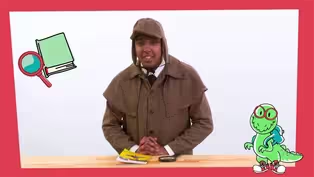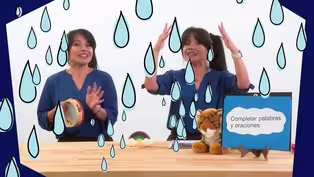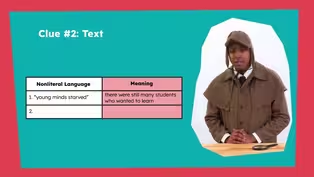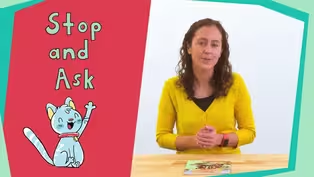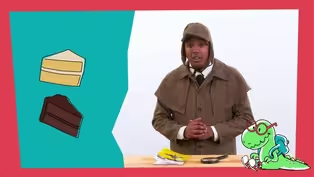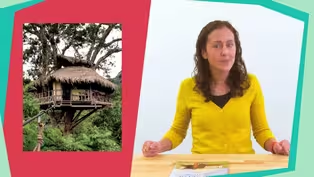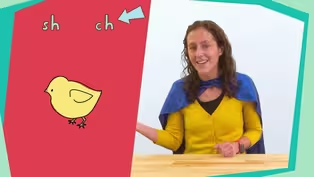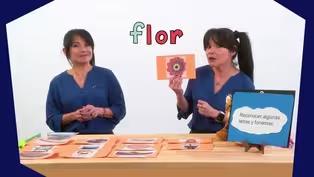
Episode 40 | Literacy Lessons
5/4/2021 | 28m 46sVideo has Closed Captions
Literacy lessons for early learners, led by NC teachers.
In the first lesson (aimed at 3rd graders) learners will understand how to recount a fable. The second lesson (aimed at PreK-K) learners) teaches students the concepts of print and how to recognize the letter Ii and its sound. Classroom Connection is your At-Home Learning companion where children love to learn. All lessons are led by NC educators.
Problems playing video? | Closed Captioning Feedback
Problems playing video? | Closed Captioning Feedback
At-Home Learning Presents: Classroom Connection is a local public television program presented by PBS NC

Episode 40 | Literacy Lessons
5/4/2021 | 28m 46sVideo has Closed Captions
In the first lesson (aimed at 3rd graders) learners will understand how to recount a fable. The second lesson (aimed at PreK-K) learners) teaches students the concepts of print and how to recognize the letter Ii and its sound. Classroom Connection is your At-Home Learning companion where children love to learn. All lessons are led by NC educators.
Problems playing video? | Closed Captioning Feedback
How to Watch At-Home Learning Presents: Classroom Connection
At-Home Learning Presents: Classroom Connection is available to stream on pbs.org and the free PBS App, available on iPhone, Apple TV, Android TV, Android smartphones, Amazon Fire TV, Amazon Fire Tablet, Roku, Samsung Smart TV, and Vizio.
Providing Support for PBS.org
Learn Moreabout PBS online sponsorshipMore from This Collection
Video has Closed Captions
Literacy lessons for early learners, led by NC teachers. (28m 46s)
Video has Closed Captions
Literacy lessons for early learners, led by NC teachers. (28m 46s)
Video has Closed Captions
Literacy lessons for early learners, led by NC teachers. (28m 45s)
Video has Closed Captions
Literacy lessons for early learners, led by NC teachers. (28m 45s)
Video has Closed Captions
Literacy lessons for early learners, led by NC teachers. (28m 46s)
Video has Closed Captions
Literacy lessons for early learners, led by NC teachers. (28m 46s)
Video has Closed Captions
Literacy lessons for early learners, led by NC teachers. (28m 45s)
Video has Closed Captions
Short Description: Literacy lessons for early learners, led by NC teachers. (28m 45s)
Video has Closed Captions
Literacy lessons for early learners, led by NC teachers. (28m 45s)
Video has Closed Captions
Literacy lessons for early learners, led by NC teachers. (28m 45s)
Video has Closed Captions
Literacy lessons for early learners, led by NC teachers. (28m 45s)
Video has Closed Captions
Literacy lessons for early learners, led by NC teachers. (28m 45s)
Providing Support for PBS.org
Learn Moreabout PBS online sponsorship[cheerful upbeat music] ♪ - Hi, friends.
Welcome to another awesome day of "Classroom Connection."
I'm Mr. R, and I'm so glad to see you today.
Did you know that this space right here, this space right here, is magical?
Yeah, it's true!
And you know why?
Because this is where learning happens, and learning is the most magical thing ever!
I love learning new things.
Do you?
I know you do.
Today is going to be so much fun.
We're going to learn about reading as well as art and science, but mostly we're going to have some fun.
So let's jump in.
- Hi, everyone.
My name is Ms. Shakemia and I'm so excited to learn with you all today.
Did you know that the texts we read can do more than just entertain us?
They can also teach us major lessons about life.
[bird chirping] A little birdie told me that you already know all about fables.
So let's do a quick review.
Fables are short stories, typically featuring animals as characters, that teach us a lesson or moral.
Today we are gonna learn about recounting stories, which is just retelling the events of a story in the order in which it took place.
After reading any story, it's important that we can recount because it helps us communicate what happened in the order that it happened, helping us to better comprehend or understand what we read.
We recount all the time.
For example, have you ever been asked to share your favorite birthday celebration, what you did over the weekend, or how your day was at school?
Well, if you've shared the events that took place in a specific order, then that means you recounted your very own story.
Sharing events in order is a great way to practice your recounting skills.
When we recount stories, there are three components that we must include.
First, we must identify the main characters and the setting, meaning we have to explain who is in the story and where and when the story takes place.
Second, we must identify the most important events that happen at the beginning, middle, and end of the story.
I like to refer to these events as B for beginning, M for middle, and E for ending.
There are lots of things that can happen during a story, but we want to narrow it down to the most important ones, also known as key details.
When thinking about what happened in the beginning of a story, we want to look at the very first important event that took place.
When thinking about the middle of a story, we should ask ourselves what problem the characters faced.
And the end of a story includes how the problem was resolved and what the characters learned as a result of the events that took place.
Third, we must determine the central message or moral of the story.
What do I mean by the moral of the story?
Excellent, you all remembered that the moral of the story is a lesson learned by the characters.
So recounting a story must include the characters and the setting, the most important events in chronological order, and the moral or lesson of the story.
We are going to read "The Wind and the Sun" to practice our recounting skills.
As I read this fable, I want you to listen for the characters and the setting and the three parts needed to recount a story so that you'll be able to share the events that took place in chronological order.
Here we go.
Make sure you have your listening ears on: One beautiful day in the park, the sun and the wind were having a chat.
The wind boasted, "I am so much stronger than you."
The sun just smile politely, but did not say a word.
"Since you don't believe me, let's have a competition to see who's stronger!"
said the wind, flexing its muscles.
The sun reluctantly nodded his head in agreement.
At that moment, they saw a man wearing a jacket out for a stroll, a very slow walk, to get some fresh air.
The wind said, "Whoever can make the man remove his jacket first is stronger!"
The sun agreed and told the wind to take the first turn.
The wind, with all of his might, began to blow and blow.
The man gripped his jacket tighter and tighter.
The wind continued to blow harder and harder, but the stronger the wind blew the tighter the man held onto his jacket.
The wind blew until its cheeks were on fire, but ultimately couldn't remove the jacket from the man.
Next, it was the sun's turn.
At first, the sun smiled warmly and its rays beamed very gently on the man.
The man start to feel a bit warm and began loosening his grip on the jacket.
As the sun went on smiling, shining brighter and brighter, the man felt warmer and warmer.
Finally, he took off his jacket.
The wind whirled in defeat and the sun simply continued to smile warmly, not saying a word.
[gentle music] Okay, now that I've read the story, I want you to help me gather my thoughts using this graphic organizer.
You can use this graphic organizer with any story that you're reading.
I'm going to fill it all in so we can reference it when we are ready to recount the story.
For this particular story, we already have the moral filled in for us.
That's because our focus today is primarily on recounting.
What's the very first thing I need to identify in order to recount the story?
That's right.
I have to identify the main characters and setting.
As I think back to the story, there were three characters: the sun, the wind, and the man.
Hmm.
But which characters do you think are the main or the most important characters?
I think you're right.
The sun and the wind were the most important characters.
So let's add that to our graphic organizer.
Now I need to identify the setting.
Remember that the setting includes where and when the story takes place.
When the story takes place refers to a day or time, however, where the story takes place refers to a specific location.
Let's reread the first sentence and see if we can figure out when and where this story takes place.
Once you have an idea, give me a thumbs up.
Are you ready?
Let's begin.
"One beautiful day in the park, the sun and the wind were having a chat."
Now we'll take a few seconds to think about the when and the where the story's taking place.
Give me a thumbs up when you have an idea.
[air whooshing] I see lots of you have an idea.
I'm going to count to three, and I want you to tell me when and where this story takes place.
Ready?
One, two, three.
Oh, that's right.
The story takes place on a beautiful day, that's the when, in the park, that's the where.
If we look back in the text, we can see that in the first sentence.
See?
All right, let's add that to our graphic organizer.
Next, I'm going to identify the most important event that happened at the beginning of the story and add it to my graphic organizer.
The beginning of the story is usually when we meet the main characters.
Let's think back to when we first met the wind and the sun, and think about the most important event.
Hmm.
Well, I remember that at the beginning of the story, wind and the sun were talking, but I need to support my thinking with key details from the text.
I want you to find a sentence that supports my thinking about the most important event at the beginning of the story.
Once you find the sentence, show me a thumbs up.
Ready?
Go.
Great.
I see lots of thumbs.
It's the first sentence that confirms the wind and the sun were having a chat.
Let's make sure we put the very first important event in our graphic organizer, where we can find key details to support the thinking of the text.
Awesome job revisiting the text to find key details that support your thinking.
Now it's your turn.
You're going to revisit the text to identify the most important events in the middle and end of the story.
But don't worry.
I'll be here to support you the entire time.
First up, let's identify the most important event in the middle of the story.
Remember, we are looking for the problem that the characters encountered.
What was that?
If you're thinking that the problem was that the sun and the wind disagreed about who was stronger, then you are correct.
But remember, we have to go back in the text to make sure that we're right.
What key details can you find to support your thinking?
[bright music] Great job.
I found a key detail that supports this in the last two sentences of paragraph one: The wind said, "Whoever can make the man remove his jacket first is stronger!"
The sun agreed and told the wind to take the first turn.
Let's add this information to our recounting graphic organizer.
Now we need to determine what happened at the end of the story.
What are we looking for specifically?
That's right.
We are looking for the solution to the problem.
I want you to think, how was this problem solved?
Hmm.
Ah, I think you're right.
The problem was resolved by the sun and the wind engaging in a competition to see who could get the man to take off his coat first, and the sun won.
But before we write it down, we must prove it.
Scan the text to find the sentence or sentences that explain the solution.
Yes, paragraph three explains how the sun won the competition by getting the man to remove his jacket by shining and smiling warmly.
Let's add that to the graphic organizer.
Great job.
The only part left is to identify the moral of the story.
And as I shared at the beginning of our time, I provided you with that today.
So let's read that together.
"It's much easier to persuade someone to do something by being gentle and kind."
Well, we reached our goal for today.
And that means we get to celebrate.
Let's kiss our brain because we did a lot of hard work today.
On three, kiss your brain for all of the hard work it did today.
One, two, three.
[lips smacking] Today we learned how to recount stories and why it's important to our comprehension.
When you recount a story, you must include the characters and setting, the most important events at the beginning, middle, and end of the story in chronological order, the moral or lesson of the story.
Remember that you can recount the events of any story that you read.
You can also use our recounting graphic organizer with any story as well.
So I want you to take what you learned today and go recount the events of "The Wind and the Sun" or another familiar story to someone at home.
I hope you have all enjoyed learn together today because I've had a blast.
See you next time, have an awesome day!
[air whooshes] - The arts have made me the person I am today because I have been able to grow as a person using art to express myself.
How do you most like to express yourself?
Let's watch this awesome video about art and you can think of a new way to express the inner you.
- Hi, kids.
Welcome to an episode of "Paint N Sippy Cup."
I am your host, Auntie Gem.
And today I am going to be painting an apple.
To go along with my apple, I have apple juice in my sippy cup.
What kind of juice are you sipping on today?
I will be using this canvas to paint on, but also you can paint on anything else you may have in your house, including paper or cardboard.
The paint colors I'll be using are red, yellow, green, and black, but you can use whatever colors you choose.
[relaxing ambient music] I also have a couple of paint brushes, which include kind of a wider one, kind of a medium one, and a smaller one.
And of course, I have a little water to go with my paint.
I'm gonna start off with our apple by drawing it.
So I have my apple drawn.
First thing we're gonna do is start on the background.
So, now that we have our background painted, I will begin on the apple.
And just remember, your apple can be whatever color you want.
If you want a pink apple, make it pink.
If you want a blue apple, make it blue.
If you want a green apple, make it green.
I just so happen to be making a red apple today.
I'm also gonna use this black to help outline my apple to make it really pop out.
I'm also gonna make sure that I put my name on it before I finish so that people don't forget that Auntie Gem made it.
So I'll put my name in the corner.
And just remember that you can do all kind of things to make this painting unique.
You can add eyes and a smiley face and make it a happy apple.
You can add dots and zigzags into the background.
So, there you have it, kids.
We have a very simple apple here.
Just remember that you can add whatever you want to your art to make it unique.
You don't have to paint like me.
You can paint like you.
This is just one way to do it.
Thanks for joining me on another episode of "Paint N Sippy Cup."
I can't wait to see what you create, and I'll see you next time.
- Okay.
So here's a really cool reading lesson for all you pre-K and kindergartners.
I heard this one is really super duper good.
So you don't wanna miss it.
Here we go.
[chill music] - Hello, super learners.
My name is Ms. Jennifer, and I'm so excited that you are here to learn with me today.
You will need a piece of paper, a pencil, and a stuffed animal for today's lesson.
Ask a trusted adult to help you find these items.
While you're getting your supplies, I'm gonna grab mine.
I'll be right back.
[bright music] Okay.
[air whooshes] I'm back now, and I see you are too.
We have our supplies, so let's go.
Today we are gonna read a story about a mother pig who can't find her piglets.
We will review the parts of a book, review the letters P and G, and learn the letter I.
We will also learn about some animals.
Let's get started.
The last time we were together, we used a circle map to help us think about the letter P and some words that begin with the puh sound.
We named pepperoni pizza, puppy, paint brush, and pickle.
We also used a circle map to think about the letter G and some words that begin with the guh sound.
We named grapes, gate, and green grass.
Now, we are gonna learn about the letter I.
The letter I looks like this.
We write it by starting at the top and making a straight line down.
Then we jumped back to the top and make a straight line that goes from left to right.
Then we're gonna jump down to the bottom and make another line that goes from left to right.
Let's all get out our magic finger and write the letter I in the air.
Start at the top, make a straight line down, then jump back to the top and make a straight line that goes from left to right, then jump down to the bottom and make another line from left to right.
The letter I makes the sound ie.
Say it to your stuffed friend.
Ie.
Ie.
Ie.
Now turn and say it to me.
Ie.
Good job saying the ie sound.
We're going to use a graphic organizer called a circle map to help us think about the letter I and the things that begin with its sound: ie.
[air whooshes] You can make your own circle map using a piece of paper and a pencil or crayons.
First, you draw a small circle on your map.
[upbeat music] Then, you're going to write what you think or what we're thinking about in the small circle.
Today we are thinking about the letter I, so we should write the letter I in the small circle.
So again, start at the top, make our straight line down.
Then go back to the top, make our line from left to right, then at the bottom, make another line from left to right.
Then we're gonna draw our big circle around our small circle.
Now you have a circle map.
Super learners, I need your help so that we can fill in the circle map with things that begin with the sound ie.
I will give you a clue and you try to guess what I'm thinking of.
Are you ready?
Great.
I am thinking of an animal that is only one inch long.
It moves by sliding its body together and stretching it back out.
Can you tell your stuffed friend what I am thinking of?
Did you say inchworm?
That's right.
Great thinking.
Can you show your stuffed friend how to move like an inchworm?
Now, I'm gonna write the word inchworm on the circle map.
Hmm.
Inchworm.
What is the first sound in the word inchworm?
That's right.
Ie.
Which letter do we need to spell that sound?
That's right.
We spell the sound ie with the letter I.
Then we need N-C-H-W-O-R-M. That spells inchworm.
Now, I am thinking of an animal that lives in trees.
It is green and eats plants.
Can you tell your stuffed friend what I'm thinking of?
Did you say iguana?
That's right!
Great thinking.
Can you show your friend how to eat plants like an iguana?
[lips smacking] Now, I'm gonna write the word iguana on the circle map.
Hmm.
Iguana.
What is the first sound in the word iguana?
That's right, ie.
Which letter do we need to spell that sound?
That's right.
We spell the sound ie with the letter I, then we need G-U-A-N-A.
That spells iguana.
Wow, super learners!
Our circle map looks great.
Look at those I words we know.
Thanks for helping.
Now, let's get ready to read our book.
Here is our book.
It is titled "Little Piglets."
A book has several parts.
This part is called the front cover.
It has the title, tells the author and illustrator, and has a picture to show us what the story is about.
This is the back cover.
When we open our book, the very first page we come to is called the title page.
We call this page the title page because it has the title on it.
Tell your friend what is a title page?
Say the title is the name of the book.
Do you see the title?
Right.
Look at me and say the title is the name of the book.
In this story, Mother Pig has lost her piglets.
I remember when I lost my favorite purple pen.
I looked everywhere.
I was so sad when I couldn't find it.
Then, I went to write in my notebook, and there it was.
I was so happy.
Have you ever lost anything?
What happened when you lost it?
How did you feel when you couldn't find it?
How did you feel when you found it?
Tell your stuffed friend what happened when you lost something.
[bright music] Oh wow.
Now, let's turn our page and see what happens when Mother Pig can't find her piglets.
As we are reading, let's count the animals we see in the story.
"'Where are my piglets?'
says Mother Pig.
'I will look for them.'
Mother Pig looks by the pond.
She sees little ducklings."
Let's count them.
One, two, three.
"But her little piglets are not there.
Mother Pig looks by the house.
She sees little chicks."
Let's count them.
One, two, three.
"But her piglets are not there.
Mother Pig looks by the gate.
She sees little lambs."
Let's count them.
One, two.
"But her little piglets are not there.
Mother Pig looks by the barn.
She sees little kittens."
Let's count them.
One, two, three.
[gentle music] "But her little piglets are not there.
Then Mother Pig sees five little pink tails.
And Mother Pig sees her little piglets."
Let's count them.
One, two, three, four, five.
That's great.
I am so glad that Mother Pig found her piglets.
Are you?
Wow, we counted a lot of little animals.
Tell your stuffed friend how many animals you counted.
Great counting.
All right, super learners.
That is the end of our lesson for today.
Thank you so much for being with me as we reviewed the letters P and G and learned about the letter I. I hope you enjoyed the story about Mother Pig in her search for her piglets.
Keep looking for words that begin with the letters P, I, and G. When you find new P, I, or G words, add them to your circle maps.
I'll see you next time.
[gentle chime music] - Wow!
What a day so far!
So much great learning going on.
Next, we're gonna watch a video about nature that I know you'll love.
[chill music] - Hi, everybody, my name is Kat Lewandowski.
I am one of the aviculturists here at Sylvan Heights Bird Park, and welcome to our "Keeper Talk."
You can see I got a very special friend with me today.
He is known as a wood duck, and across the pond in the UK, in Europe, they often call this the Carolina wood duck.
And that's because here in North Carolina, these birds are native and very common, especially in the Eastern parts of the state where we are here in Scotland Neck, North Carolina.
Now, he's being very happy and active today.
Now, a lot of things that people notice about the wood duck is their gorgeous colors.
So only the boys look like this.
The females are primarily gray with a bit of white stripes around the face.
And there's a reason for this.
We are in the spring months of the year and that means it's the breeding season for these birds.
And so the males have to put their best foot forward by showing off these bright, gorgeous colors.
So the brighter the male, the more attractive he is to the female.
And so that is the only reason he has these really, really bright colors and he cannot wait to show them off to all the ladies.
[laughs] Another fun thing about wood ducks is what the females do during the breeding season.
So to find a nesting site, they find a tree such as a longleaf pine tree or anything like that with a cutout hollow that was made by, say, a squirrel or a raccoon, and they'd go inside these nest cavities and they can lay upwards of 15 eggs.
That's a lot of eggs for one bird!
And she will incubate for upwards of 30 days, give or take.
That is the average length of incubation for a wood duck.
Now, when she hatches out her little ducklings, she can't take care of them in that tree.
So she has to lead them to water.
And so, for the first day of the duckling's life, they already have an adventure.
They have to take a leap out of the tree, which can be as high as 50 feet, and hit the forest floor and then go find their mother who is often in a pond very close by.
And that's where they start their life.
Well, thank you, everybody, for joining us today at our "Keeper Talk."
We'll see you again next time.
- Wow.
Time sure does fly when you're learning and having fun.
I wanna thank you so much for joining us today on PBS North Carolina.
You are so smart, so special, and so fun to be with.
Wishing you peace, love, and learning, my friends.
[cheerful upbeat music] ♪
Support for PBS provided by:
At-Home Learning Presents: Classroom Connection is a local public television program presented by PBS NC
